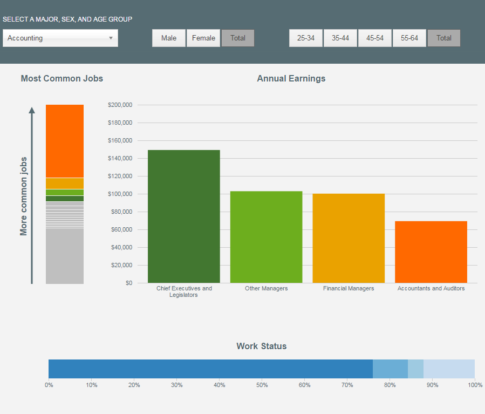This blog post explores the online interactive tool, “Putting Your Major to Work: Career Paths after College.”
With graduation season underway, college seniors across the nation are preparing to embark on their careers. For some students, their career path follows directly from what they majored in; others may find their undergraduate course of study less immediately relevant to their work in the years following graduation. In fact, many students with the same college major explore a variety of occupations and career paths, which can impact their probability of employment as well as earnings for decades to come.
A college degree is a worthwhile investment. College graduates enjoy greater earning power—on average, about $600,000 more in lifetime earnings—than workers with only a high school education. However, not all college experiences are equal, as graduates of some majors earn significantly more than graduates of others. Typically, students who have majored in quantitative fields (i.e., STEM) tend to enter more lucrative industries and earn more than students who have studied the arts or humanities. Even so, liberal arts majors—like most graduates—find their ways into a wide variety of occupations with very different earnings levels.
In a new Hamilton Project report and accompanying interactive tool, we examine the tremendous diversity of career paths that students within the same college major take after college. We find that college majors relate to graduates’ future employment status; gender and age are factors that relate to employment status; and earnings outcomes vary greatly for graduates of the same college major.
The online interactive tool draws on data from the American Community Survey and allows users to explore 171 college majors to answer numerous questions, including:
- What are the most common occupations within an undergraduate major?
- What percentage of graduates are working in fields directly related to their college major?
- What percentage of individuals with a particular major are employed full-time, employed part-time, unemployed, or not seeking employment?
- How do career paths and earnings shift, within a college major, when age and gender are taken into account?
As an illustrative example, let’s consider what career paths psychology majors take after college. Following business administration and management, and general business, psychology is the third most common major in our data. Psychology majors also pursue a particular wide variety of career paths.

The figure above is a screenshot of the interactive. To the left is a single bar chart displaying the most common jobs for a particular major, in this case, psychology. To the right of this is another chart displaying annual earnings for the most common jobs. Beneath this, you can glean information about where psychology majors end up in the labor force – full-time employed, part-time employed, seeking employment – or if they’re not seeking work. At the very top of the interactive, you can select buttons to examine the data by age and gender.
Taking a closer look at the “Most Common Jobs” figure, we learn that:
- 6.6 percent of psychology majors become social workers, the most common profession for the major;
- Following social workers, the most common jobs are counselors, followed by elementary and middle school teachers, postsecondary teachers, and psychologists.
- Psychology majors still enter many other fields. For example, 2.1 percent of all psychology majors become physicians or surgeons.
The interactive also illustrates that variation in earnings for psychology majors is linked to their choice of profession after college. As shown above on the right-hand side, the median annual earnings is lower for social workers, who earn approximately $43,000, and higher for psychologists, who earn nearly $64,000.
At the bottom of the figure, we see that about two-thirds of psychology majors are employed full-time.
The interactive tool also shows that career paths and earnings differ by age and gender. Men and women who major in psychology are taking different career paths at different rates; for example, social work is the most common job for women and the third most common for men. There is also more variation in earnings between the top jobs employing male psychology majors than there is for the top jobs employing female psychology majors. In fact, earnings is about the same for the top jobs employing female psychology majors.


Notably, in occupations that both male and female graduates commonly pursue, gender pay gaps appear frequently. For example, men and women psychology majors who become psychologists earn a median annual salary of $83,000 and $59,000, respectively.
These findings align with previous research on the gender pay gap, and with our own research, which found that employed women earn less than their male counterparts. After adjusting for differences in college majors, we found the women make approximately:
- 23 percent less at 25-34 years old;
- 36 percent less at 35-44 years old;
- 39 percent less at 45-54 years old; and,
- 33 percent less at 55-64 years old.
While the tremendous diversity of career paths for men and women of all ages is interesting in its own right, it also has practical implications for prospective students and their families. Understanding the ways that college major, occupation, and earnings interact is important not only for the career decisions made by college graduates, but also for assessments of our nation’s education policy.




